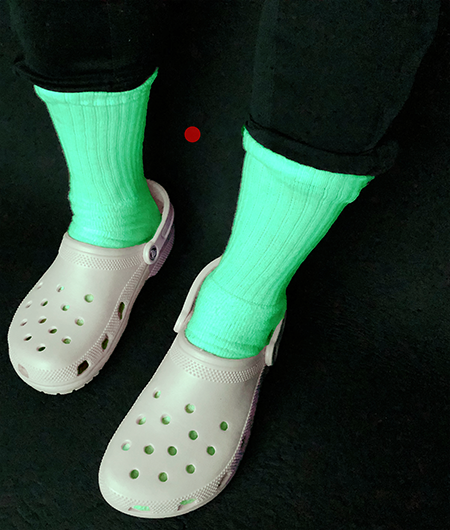- This has nothing to do with being left or right brained. People love brain based explanations, and this phenomenon has one, but a different one – see below.
- “This thing, yet again” seems to unsettle some people, but it is neither silly, nor should you feel bad that you see things differently than others. What is going on sheds light on how the mind works normally to bring about perception.
- Most people think they see things just how they are, but a lot of things have to be taken into account to make that happen reliably.
- For instance, an object that appears to be red could look like that either because its surface properties reflect red light*, or because it is illuminated by red light to begin with.
- Our brain contains mechanisms that take the kind of light into account to color-balance the perceptual experience. In other words, if everything is bathed in red light, the brain can take that into account. This allows the brain to render the appearance of the object consistently, regardless of changing light colors. This process is called color constancy.
- In some images – like “the sneaker” – a pink sneaker was illuminated with complementary – green – light to make it appear grey. Context is missing, so people cannot apply color constancy mechanisms in the usual way.
- However, there are subtle cues – shoelaces are usually white, so the green light will render them green. Some people – who know that shoelaces are usually white can unconsciously take that into account to deduce that the light must have been green and color-correct to see the sneaker as pink.
- We know this because whereas displays like the sneaker, the dress, the Adidas Jacket or “Laurel & Yanny” came about accidentally, we applied these principles – which we call SURFPAD – to design and create a new display: The crocs. And we are the first ones to do so successfully.
- We used green lights to illuminate pink crocs to make the pixels appear as grey. But that light will make the socks look green, so those who know that socks like that tend to be white can account for that and perceive them as pink. This knowledge about the whiteness of these socks seems to come from experience. Moreover, people who are able to do this – see the sneaker as pink even though the pixels that make it up are grey – tend to be the same people who see the crocs as pink.
- The reason this is not frivolous to ponder these phenomena that it highlights the tremendous mental work – such as taking experience and context into account – that goes into normal perception that we typically take for granted. Moreover, in these highly polarized times, it highlights why you might disagree with someone, even though you both have access to the same evidence. If someone looks bad in the media, how do you know whether they are actually bad or because they are put into a bad light by the media? Where you come down on that depends on how well you know the person vs. how much you trust the media.
If you have a couple of minutes and want to help us get to the bottom of some of the more subtle aspects of sneakers, crocs and the like, you can click here to donate your data.
*We are aware that lights don’t have colors. Notoriously, lights are not themselves colored, as the color experience is created in the brain. However, light – a form of electromagnetic radiation – has a frequency, which corresponds to a certain wavelength. Humans see lights in a relatively narrow wavelength range, typically between about 400 and 700 nm. Radiation with longer wavelengths (think a laser with 650 nm) is typically perceived as red, whereas one at 441 is perceived as blue. Generally, lights with longer wavelengths reddish, shorter blueish. Being aware of all that, we say “red light” as shorthand for light that contains power at predominantly long wavelengths, to make for a more concise text, much like neuroscientists say that neurons have “tuning preferences” (say for stimuli of a certain orientation or spatial frequency), being fully aware that people have preferences, neurons (lacking agency) do not. In other words, most neuroscientists say that neurons have preferences as a shorthand to make communication more efficient, they are not committing a mereological fallacy, as they are sometimes accused of by philosopher. The same applies here to our use of colored lights or pink shoes – the “pink shoe” is shorthand for a shoe that appears pink to most observers without visual impairments and under typical lighting conditions.

